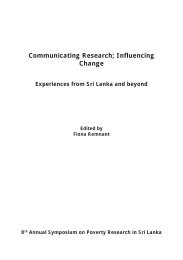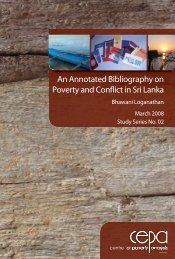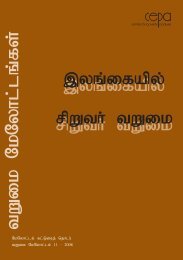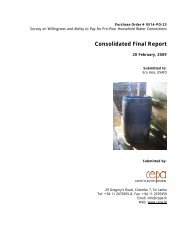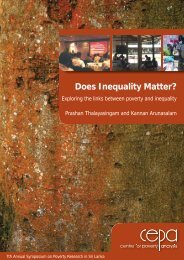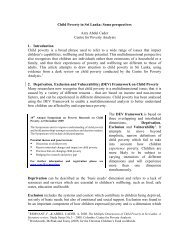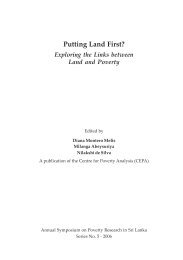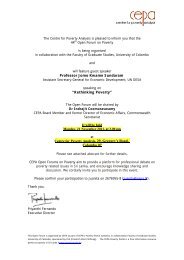Involuntary Displacement and Resettlement â Policy and ... - CEPA
Involuntary Displacement and Resettlement â Policy and ... - CEPA
Involuntary Displacement and Resettlement â Policy and ... - CEPA
- No tags were found...
Create successful ePaper yourself
Turn your PDF publications into a flip-book with our unique Google optimized e-Paper software.
In October <strong>and</strong> November 2007, the same TSST assessment team conductedin-depth interviews with 254 families, approximately 20% of the familiesliving in transitional shelter in Colombo at that time.2 Results <strong>and</strong> DiscussionFemale-headshipThe results found a large number of these families, higher than the nationaldistrict average of 22% (Goonesekere, 2006:47), were female-headed (Table3). Some of these women were widows, but others had husb<strong>and</strong>s who werein jail for drug use, husb<strong>and</strong>s who had ab<strong>and</strong>oned them, or had assumed defacto headship in other ways 10 .Table 3: Female headship in the Colombo District (by DSDivision)% of female headship intransitional shelter sites(Nov 2007)Colombo Dehiwala Ratmalana Moratuwa59 35 39 24As this was the first assessment of its type conducted in Colombo, there isno comparable baseline to ascertain changes in female headship intransitional shelter across time. The Jayaweera (2005) study in Colombofound that 17% of the households were female headed (N=75), butconsidering that the number of displaced families in Colombo at the end of2007 was over 1,300 in camps alone, 75 families is a very small number toconsider an appropriate baseline. Another multi-district study conducted byCENWOR 11 , which did not cover the Colombo District, found that thepercentage of female-headed households affected by the tsunami rangedfrom 13% in Jaffna to 39% in Batticaloa (Goonesekere 2006:10). These areamong the only studies that examine women’s issues in such detail in the earlypost-tsunami period. Both of these studies were completed by September 2005(nine months after the tsunami), whereas the data in Table 3 was collectedthree years after it. Considering that female heads with unmet housing10Both de jure <strong>and</strong> de facto female headship were considered, with de jure referring to widowhoodor legal divorce <strong>and</strong> de facto meaning that a woman was either co-habitating or legallymarried to but separated from her husb<strong>and</strong> or her husb<strong>and</strong> is in jail, physically disabled,mentally unfit to work, is an alcoholic, or has a major illness <strong>and</strong> does not work. In the case ofde facto headship, the woman is financially <strong>and</strong> otherwise responsible for the wellbeing of thehousehold (Ruwanpura, 2006).11 In this study, 1,206 households were interviewed in six districts (Goonesekere, 2006: 9).185



